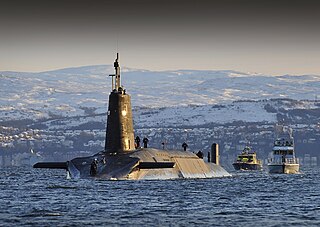| 10th Submarine Squadron | |
|---|---|
| Active | 1966 – October 1993 |
| Country | |
| Branch | |
| Size | Squadron |
| Garrison/HQ | Faslane |
The 10th Submarine Squadron was an administrative unit of the Royal Navy.
| 10th Submarine Squadron | |
|---|---|
| Active | 1966 – October 1993 |
| Country | |
| Branch | |
| Size | Squadron |
| Garrison/HQ | Faslane |
The 10th Submarine Squadron was an administrative unit of the Royal Navy.
The squadron was formed at HMNB Clyde, Faslane, Scotland, in the 1960s to direct the Resolution-class submarines equipped with Polaris missiles that formed part of the United Kingdom's strategic nuclear deterrent. The four Resolution-class submarines would carry out a total of 229 operational patrols during their time in service with the squadron. [1]
The squadron would later direct the Vanguard-class submarines equipped with Trident missiles.
In October 1993 the 3rd and 10th Squadrons at Faslane amalgamated into a new 1st Submarine Squadron (Watson).
In February 2002 all existing squadrons were disbanded and replaced by three flotillas at the base ports of Devonport, Faslane and Portsmouth.
| Name | Laid down | Launched | Commissioned | Maiden patrol | Fate |
|---|---|---|---|---|---|
| HMS Resolution | 26 February 1964 | 15 September 1966 | 2 October 1967 | decommissioned 1994 | |
| HMS Repulse | 12 March 1965 | 4 November 1967 | 28 September 1968 | decommissioned 1996 | |
| HMS Renown | 25 June 1964 | 25 February 1967 | 15 November 1968 | decommissioned 1996 | |
| HMS Revenge | 19 May 1965 | 15 March 1968 | 4 December 1969 | decommissioned 1992 | |
| HMS Vanguard | 3 September 1986 | 4 March 1992 | 14 August 1993 | December 1994 | in service |
| HMS Victorious | 3 December 1987 | 29 September 1993 | 7 January 1995 | December 1995 | in service |
| HMS Vigilant | 16 February 1991 | 14 October 1995 | 2 November 1996 | June 1998 | in service |
| HMS Vengeance | 1 February 1993 | 19 September 1998 | 27 November 1999 | February 2001 | in service |

The Resolution class was a class of four nuclear ballistic missile submarines (SSBN) built for the Royal Navy as part of the UK Polaris programme. Each submarine was armed with up to 16 UGM-27 Polaris A-3 nuclear missiles.

The Vanguard class is a class of nuclear-powered ballistic missile submarines (SSBNs) in service with the Royal Navy. The class was introduced in 1994 as part of the Trident nuclear programme, and comprises four vessels: Vanguard, Victorious, Vigilant and Vengeance, built between 1986 and 1999 at Barrow-in-Furness by Vickers Shipbuilding and Engineering, now owned by BAE Systems. All four boats are based at HM Naval Base Clyde , 40 km (25 mi) west of Glasgow, Scotland.

A ballistic missile submarine is a submarine capable of deploying submarine-launched ballistic missiles (SLBMs) with nuclear warheads. The United States Navy's hull classification symbols for ballistic missile submarines are SSB and SSBN – the SS denotes submarine, the B denotes ballistic missile, and the N denotes that the submarine is nuclear powered. These submarines became a major weapon system in the Cold War because of their nuclear deterrence capability. They can fire missiles thousands of kilometers from their targets, and acoustic quieting makes them difficult to detect, thus making them a survivable deterrent in the event of a first strike and a key element of the mutual assured destruction policy of nuclear deterrence.

The Romanian Navy is the navy branch of the Romanian Armed Forces; it operates in the Black Sea and on the Danube. It traces its history back to 1860.
A submarine squadron (SUBRON) is a naval formation or unit in such states such as the United Kingdom, United States, and Russia/Soviet Union. In France the equivalent unit is the escadrille des sous-marins nucléaires d'attaque (ESNA), part of the French submarine forces.

The Israeli Navy is the naval warfare service arm of the Israel Defense Forces, operating primarily in the Mediterranean Sea theater as well as the Gulf of Eilat and the Red Sea theater. The current commander in chief of the Israeli Navy is Aluf David Sa'ar Salama. The Israeli Navy is believed to be responsible for maintaining Israel's offshore nuclear second strike capability.

His Majesty's Naval Base, Clyde, primarily sited at Faslane on the Gare Loch, is one of three operating bases in the United Kingdom for the Royal Navy. It is the navy's headquarters in Scotland and is best known as the home of Britain's nuclear weapons, in the form of nuclear submarines armed with Trident missiles.

HMS Renown (S26) was the third of the Royal Navy's Resolution-class ballistic missile submarines.

HMS Revenge (S27) was the fourth of the Royal Navy's Resolution-class ballistic missile submarines.

HMS Derwent was a Hawthorn Leslie-type River-class destroyer ordered by the Royal Navy under the 1901 – 1902 Naval Estimates. Named after the River Derwent in central England, she was the second ship to carry this name.

HMS Kale was a Hawthorn Leslie type River-class destroyer ordered by the Royal Navy under the 1903–1904 Naval Estimates. Named after the Kale Water in the Scottish Borders, she was the first ship to carry this name in the Royal Navy.
HMS Ouse was a Laird type River-class destroyer ordered by the Royal Navy under the 1903 – 1904 Naval Estimates. Named after the River Ouse in north east England near the city of York, she was the first ship to carry this name in the Royal Navy.
HMS Foyle was a Laird-type River-class destroyer ordered by the Royal Navy under the 1902–1903 Naval Estimates. Named after the River Foyle in Ireland, she was the first ship to carry this name in the Royal Navy.

HMS Teviot was a Yarrow type River Class Destroyer ordered by the Royal Navy under the 1902 – 1903 Naval Estimates. Named after the River Teviot in southern Scotland near the border with England, she was the first ship to carry this name in the Royal Navy. She served during World War 1, primarily on anti-submarine duty in the Channel, and was sold for breaking up in 1919.
HMS Garry was a Yarrow-type River-class destroyer of the Royal Navy built under the 1903 – 1904 Naval Estimates. Named after the River Garry in north central Scotland, she was the first ship to carry this name in the Royal Navy.

HMS Ettrick was a River-class destroyer ordered by the Royal Navy under the 1901 – 1902 Naval Estimates. Named after Ettrick Water in the Scottish Borders area south of Edinburgh, she was the first ship to carry this name in the Royal Navy. She was launched in 1903 and served during World War I. She was torpedoed by UC-61 in 1917.
HMS Cherwell was a Palmer Type River-class destroyer ordered by the Royal Navy under the 1902 – 1903 Naval Estimates. Named after the River Cherwell in south central England near Oxford, she was the first ship to carry this name in the Royal Navy.
HMS Swale was a Palmer Type River Class Destroyer ordered by the Royal Navy under the 1903 – 1904 Naval Estimates. Named after the River Swale north east of York, she was the second ship to carry this name since it was introduced in 1841 for a lighter.

HMS Exe was a River-class destroyer ordered by the Royal Navy under the 1901–1902 Naval Estimates. Named after the River Exe in southern England flowing through Exeter in the County of Devon, she was the first ship to carry this name in the Royal Navy. She served on the China Station before World War I and in the North Sea during the war. She was sold in 1920.
HMS Ure was a Palmer Type River Class Destroyer ordered by the Royal Navy under the 1903 – 1904 Naval Estimates. Named after the River Ure in Yorkshire, England, she was the first ship to carry this name in the Royal Navy.